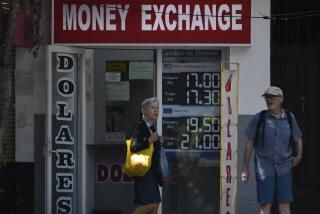Mexican Banking Officials Consider Establishment of Currency Board
MEXICO CITY — While the White House claimed progress Monday in its campaign for Mexican loan guarantees, Mexico’s central bank is studying a radical change endorsed by some top U.S. senators--the establishment of a currency board that would strip the central bank’s authority.
Sources here said bank officials are studying the possible implementation of a currency board system similar to those in effect in Argentina, Estonia and Hong Kong, which would restrict the number of pesos added to the economy by the number of new dollars entering in investment.
Enacting a currency board would, in effect, be an admission by the U.S.-trained government economists from President Ernesto Zedillo down that they are incapable of restoring investor confidence in their ability to micro-manage the economy.
A currency board would sharply restrict the newly autonomous Bank of Mexico’s ability to control the money supply or to stabilize currency flows into the country. However, it would provide an absolute guarantee that inflation would remain under control.
“A currency board is a kind of straitjacket,” said Harvard economist Jeffrey Sachs. “Currency boards are used when you really can’t trust yourself or when your behavior in the past has been so reckless and irresponsible that you have little credibility left.”
The prospect of a currency board was raised publicly over the weekend by Senate Majority Leader Robert Dole (R-Kan.) as a possible prerequisite to congressional approval of President Clinton’s proposed $40 billion in loan guarantees.
On Monday, a group of conservative Republicans advanced the idea of a currency board as an alternative to the loan-guarantee plan, which Sen. Don Nickles (R-Okla.) said “is in trouble.”
But on the House side, Speaker Newt Gingrich said he would support the Clinton plan and see to it that the measure comes up for a floor vote by Friday, or Monday at the latest.
After Gingrich’s remarks, the Mexican Stock Exchange index--which had fallen 59 points, or 2.66%, by midday--reversed course and closed up 2.64 points at 2,065.85. The reversal may also have reflected buying by Nacional Financiera, the government development bank.
Meanwhile, the effects of the crisis spread with the announcement that Wal-Mart Stores Inc. is suspending plans to construct 25 additional stores in Mexico this year, a bet by the retailer that the weakened peso will keep Mexican citizens out of stores.
The peso closed down 4 centavos at 5.74 to the dollar. It is the urgent need to strengthen the peso--which in early December traded at about 3.4 to the dollar--that has experts weighing drastic action. Currency boards were common in the colonies of European powers. Hong Kong reintroduced the concept in 1983 to avoid a crisis of confidence.
The concept gained impetus in 1991 when Argentina pegged its currency to the dollar in an effort to battle chronic inflation. Estonia and Lithuania used currency boards to build confidence in their new national currencies after they dropped the ruble in 1992.
An independent currency board is much like being on the gold standard. The board prints domestic money and converts it, on demand, to a specified foreign currency at a fixed exchange rate.
To keep this commitment, the board holds enough reserves of the foreign currency to convert all domestic currency issued at the specified exchange rate. The board will only print money when there are new foreign assets to back it.
*
Times staff writer Edwin Chen in Washington contributed to this report.
More to Read
Sign up for Essential California
The most important California stories and recommendations in your inbox every morning.
You may occasionally receive promotional content from the Los Angeles Times.










